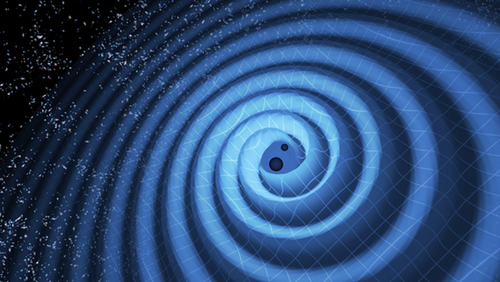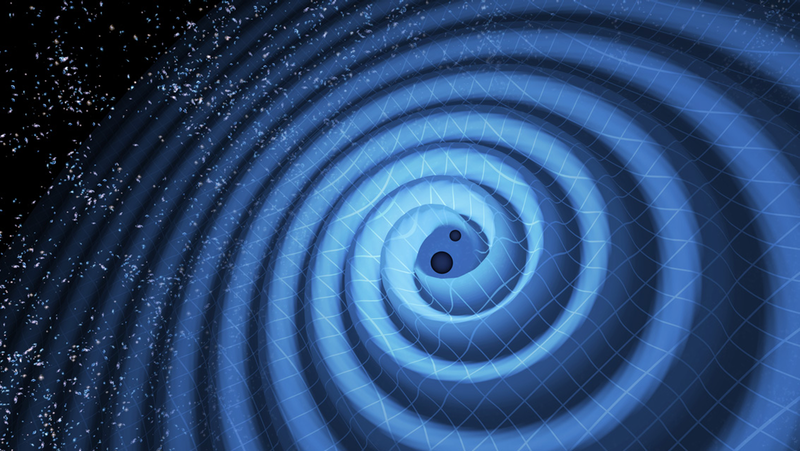LIGO Bags Another Black Hole Merger
In December, the Laser Interferometer Gravitational-Wave Observatory (LIGO) detected gravitational waves for the second time. The international LIGO and Virgo scientific collaborations report that, like the first event announced in February, the waves came from the merging of two black holes. This time, however, the black holes were smaller, which allowed the merging process to be seen for about a second, five times longer than the first event. Researchers say that after the first event proved that LIGO can work, this second detection signifies the start of the era of gravitational-wave astronomy, when detections will become routine and provide new information about the cosmos.
It has taken over a decade for LIGO to achieve the sensitivity required to make the first ever detection of gravitational waves, ripples in spacetime predicted by Einstein's 100-year-old general theory of relativity. The first event was seen on 14 September by both LIGO detectors, located in Hanford, Washington, and Livingston, Louisiana, and was interpreted as the merging of two black holes 1.3 billion light years away.
Now the LIGO and Virgo teams have described a second signal observed on 26 December in both detectors. The researchers predict that a false coincidence signal like the one observed would result from random noise less than once every million years.
The team calculates that the waves came from the merging of black holes with masses of about 14 and 8 times that of the Sun, 1.4 billion light years away. These masses are close to the typical values inferred from conventional observations of black holes orbiting ordinary stars, whereas those responsible for the first LIGO event were much larger, at 29 and 36 solar masses.
Unlike that earlier detection, the new event “did not leap out of the data,” says Sarah Caudill, a member of the LIGO team from the University of Wisconsin in Milwaukee. It became evident only after careful filtering and analysis of the data. The LIGO team has worked on this analysis in partnership with the European Virgo Collaboration—which is associated with the Virgo gravitational-wave detector near Pisa, Italy.
The second event was different from the first in several other important ways, says Caudill. The black holes were smaller, which led to different timing for the final orbits and allowed LIGO to see more of the last stages before the black holes merged—55 cycles in the new data, compared with only 10 in the earlier event. And jointly analyzing the two events permitted a more precise test for violations of general relativity, Caudill says, although no such violations were found.
“This is a very important discovery,” says Stuart Shapiro, an astrophysicist at the University of Illinois at Urbana-Champaign. “It cements the reality of the first detection and makes credible the belief that detections of this sort will be common and that we have truly opened up a new window to the Universe.”
“The first detection was so exciting because it showed that this extraordinarily hard experiment could actually be performed successfully," says Julian Krolik, an astrophysicist at Johns Hopkins University in Baltimore. “Additional detections [like this] turn the spotlight from the experiment itself to what it teaches us about the contents of the Universe.”
Perhaps the most important aspect of the new results, says Shapiro, is that the measured gravitational wave is completely consistent with the predictions of general relativity for strong gravitational fields. The theory's strong-field predictions had not been directly tested before the two LIGO events. “The theory thus passes this most stringent test for the second time,” he says.
Krolik expects that as more data accumulate, researchers will learn more about the kinds of gravitational-wave-emitting systems that are possible. “It's a pretty safe prediction that there will be an outpouring of new ideas in the near future," he says.
One other binary black hole candidate under 100 solar masses was found during Advanced LIGO's first observing period, which ended 19 January, says Caudill, but it is still being analyzed. However, the team is continung to sift through the data for larger binaries and for other sources of gravitational waves.
Krolik has high hopes that Virgo will detect a gravitational-wave event soon. The data from a third observatory would allow the source location to be pinpointed more accurately in the sky, he says. With only two detectors, the new LIGO event was traced to a large swath of sky measuring 850 square degrees.
This research is published in Physical Review Letters.
–Philip Ball
Philip Ball is a freelance science writer in London. His latest book is How Life Works (Picador, 2024).
More Information
APS News Update on this result
Collection of seven gravitational-wave articles in Physics
Recent Physics articles covering LIGO's previous detection:
The First Sounds of Merging Black Holes





